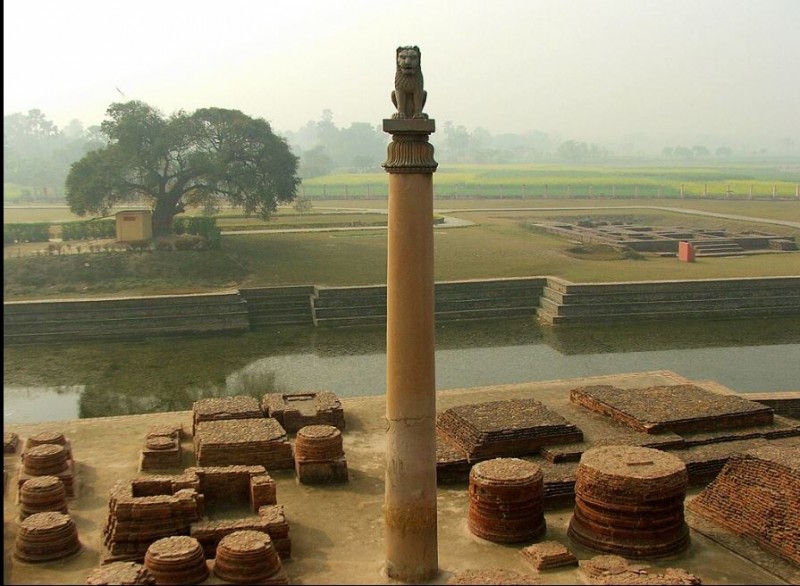
The Pillars of Ashoka stand as remarkable testament to the enduring legacy of Emperor Ashoka, one of India's most celebrated and influential rulers. These majestic pillars, scattered across the Indian subcontinent, are not merely architectural marvels, but also hold profound historical, political, and cultural significance. Erected during the Mauryan dynasty (circa 268-232 BCE), these pillars have stood the test of time, embodying Ashoka's philosophy, policies, and teachings.
Emperor Ashoka's reign marked a pivotal moment in Indian history. Initially known for his ambitious military campaigns and expansionist policies, Ashoka underwent a profound transformation following the brutal conquest of Kalinga. Overwhelmed by the carnage, Ashoka embraced Buddhism and turned towards a path of non-violence, compassion, and moral governance. It was during this transformative period that he commissioned the creation of these pillars, which served as instruments to propagate his ethical principles and policies.
Also Read: Kathmandu: A Cultural Tapestry of Nepal
The pillars are remarkable not only for their size and craftsmanship but also for the inscriptions carved onto them. These inscriptions, composed in the Brahmi script, are written in several languages including Prakrit and Greek, indicating Ashoka's desire to communicate his ideas to a diverse populace. These inscriptions provide insights into Ashoka's moral and social values, his commitment to welfare, and his vision of a just and harmonious society.
The inscriptions commonly consist of two main themes: Dhamma and policy proclamations. Dhamma, derived from the term Dharma, refers to the ethical and moral teachings Ashoka adopted from Buddhism. These teachings emphasized virtues such as compassion, non-violence, truthfulness, and respect for all forms of life. Ashoka's inscriptions reflect his aspiration to promote Dhamma as a means to maintain social order and personal well-being.
Also Read: Temple of the Sacred Tooth Relic: Sri Lanka's Buddhist Heritage
One of the most famous edicts, found at Sarnath, exemplifies this commitment to Dhamma. It reads, "One should not honor only one's own religion and condemn the religions of others, but one should honor others' religions for this or that reason. By so doing, one helps one's own religion to grow and renders service to the religions of others too." This principle of religious tolerance and coexistence is remarkably progressive for its time and continues to resonate in today's diverse world.
In addition to promoting Dhamma, Ashoka's inscriptions also outline his policy proclamations. These edicts encompass a wide range of subjects, from the welfare of humans and animals to fair administration and environmental protection. Ashoka established institutions such as hospitals, veterinary clinics, and shelters for the elderly and the vulnerable. He advocated for responsible governance, efficient administration, and equitable distribution of resources. Through these policies, Ashoka sought to alleviate suffering and create a just and humane society.
Also Read: Ruwanweli Maha Seya: Stupa of Significance
Pillars of Ashoka are not uniform in design but share distinctive characteristics. The most iconic feature is the capital, the crowning element of each pillar. These capitals are often carved in the shape of animals, primarily lions, which symbolize strength, courage, and royalty. The lion capital of Sarnath, with its four lions standing back-to-back and an emblem of the Dharma Wheel below, is particularly renowned and serves as the emblem of the modern Republic of India.
While the pillars were primarily erected across the Indian subcontinent, they also hold historical importance beyond its borders. Notably, Ashoka's inscriptions in Greek, found in places like Kandahar in present-day Afghanistan, highlight the extent of his influence. These inscriptions reveal his interest in reaching out to a cosmopolitan audience and fostering connections with other civilizations.
Also Read: Edakkal Caves: A Glimpse into Prehistoric Art and Civilization
Pillars of Ashoka have faced the challenges of time, weather, and human intervention. However, their significance has endured, and various conservation efforts have been undertaken to preserve them. Archaeologists, historians, and experts continue to study the pillars to glean insights into Ashoka's rule, his philosophy, and the socio-political landscape of ancient India.
Pillars of Ashoka stand as remarkable artifacts that encapsulate the wisdom, values, and aspirations of Emperor Ashoka. These pillars transcend their architectural beauty, serving as enduring symbols of a ruler who transformed from a conqueror to a compassionate leader. Ashoka's inscriptions on these pillars embody his philosophy of Dhamma, religious tolerance, moral governance, and commitment to the well-being of all living beings. As they continue to inspire and educate generations, the Pillars of Ashoka remind us of the potential for profound change that can stem from an individual's introspection and a commitment to creating a just and harmonious society.
Also Read: Illikkal Kallu: A Majestic Gem of Nature
Discover the Enchanting Beauty of Pachmarhi: Must-Visit Places and Attractions